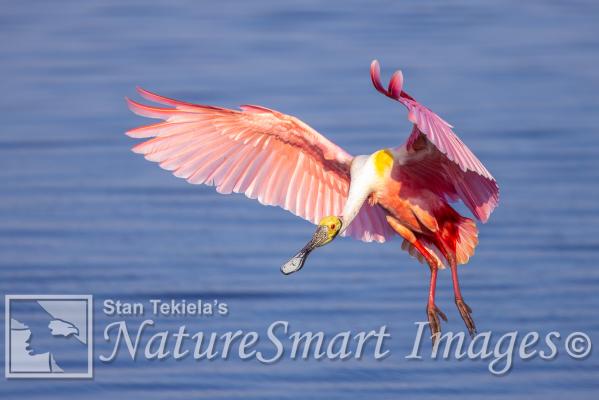View all of the titles in the
NatureSmart Bookstore

by Stan Tekiela
© NatureSmart
May 1, 2023
While guiding a photo tour in Florida last week, we where fortunate to capture some amazing images of one of North America’s most stunning birds, the Roseate Spoonbill (Platalea ajaja). Standing nearly 3 feet tall, the Roseate Spoonbill is hard to miss this pink, red, white and yellow bird. So when we came across a nesting area containing several pairs of spoonbills we knew it was going to produce some amazing images.
The Roseate Spoonbill is a highly social bird (gregarious) in the Ibis and Spoonbill family (Threskiornighidae). They nest in small colonies with other long-legged wading birds such as Great Egrets. These colonies are usually located on small islands, often in mangroves. They lay two to five eggs in a small platform nest they construct with old vegetation of aquatic plants.
In the United States they are only found in parts of Florida, Texas and Louisiana. But small populations can be found in Georgia and South Carolina. The vast majority of the spoonbills range is in Mexico and South America. Plume hunting in the early 1900’s nearly drove the spoonbill to extinction. Their beautiful bright pink feathers were used to adorn fancy hats. Major laws passed in the mid 1900’s have led to populations increasing in recent years.
As its name suggests, this bird has a long bill with a flattened, spoon-shaped tip. They feed on crustaceans, small fish, and aquatic insects. It uses its long spoon shaped bill by sweeping the bill back and forth while it walks in shallow water. The tip of the bill is packed with sensitive receptors to feel for any food items. When it bumps into a prey item it quickly snaps its bill shut and it tosses the item back into the mouth. The spoon-shaped bill also allows the bird to sweep its bill through muddy bottoms and sift out any small hidden insects.
Just like the American Flamingo, the spoonbills pink color is derived from its diet of prey that contains carotenoid pigments called canthaxanthin. The color of these birds ranges from pale pink to bright magenta red on the wings and base of tail. The older birds and breeding adults obtain the brightest colors.
After locating this nest colony, we returned for three mornings in a row to see if we could capture images of the Roseate Spoonbills in soft and warm early morning light as they flew from the nesting area to the surrounding area to pick up nesting material.
On the first morning we waited over 3 hours and while the spoonbills were flying in and out of the rookery, none came close enough to capture any images. On the second morning the warm light was blocked by some low hanging clouds which completely shut us down for the morning. We tried again in the afternoon, and we were successful at capturing images of the birds in flight but we didn’t capture the ultimate images we had hoped for.
On the third and last morning the sunlight was beautiful and slightly filtered by thin clouds. The birds seemed to be a little extra active and while we watched many of the spoonbills fly out of the rookery and off into the distance without coming close enough to capture some images, we did get a few individuals that flew directly towards us.
Each time one of the spoonbills started flying in our direction the group would all stop talking and concentrate on the birds. Capturing images of birds in flight is an art form and takes a fair amount of practice and luck. One of the fun new advances in the camera world is mirrorless technology. These new cameras can shoot at 30 pictures per second, and they do it silently. So, each time one of the spoonbills would fly towards us there was no noise from the cameras. Only after the bird landed and we started looking at the images we just took did everyone start talking again. Usually, it was more like oooh’s and awes and remarking about how incredible the images look. So, after three days we managed to capture the images of our dreams. Until next time…
Stan Tekiela is an author / naturalist and wildlife photographer who travels the U.S. to study and capture images of wildlife. He can be followed at www.instagram.com, www.facebook.com and www.twitter.com. He can be contacted via his web page at www.naturesmart.com.
The nationally syndicated NatureSmart Column appears in over 25 cities spanning 7 states: Minnesota, Wisconsin, Michigan, Illinois, Ohio, New York and Pennsylvania. It is a bi-weekly column circulated to over 750,000 readers.
Wolves
Just the day before, a pack of wolves known as the Wapiti, had found a large bull bison that was weak and injured. Based on its size, this big boy was near the end of its lifespan and the winter weather was taking its toll. For a full day the wolves tried to approach the bison but when the bison...
Moose
It was one of those dark and cloudy winter days in Yellowstone National Park where the clouds are so heavy and low, you feel like you can reach up and touch the cloudy sky. A light wind helped to blow the falling snow with occasional gusts of wind causing swirls of fluffy white snow...
American Badger
It’s funny, I believe the average person knows more about the Honey Badger (Mellivora capensis), a critter of Africa and Southwest Asia than they do about the badger in our own backyard, the American Badger (Taxidea taxus). Social media has a lot to do with the Honey Badger phenomena and...
Backyard Bird Feeding
Winter bird feeding is one of the most common / popular hobbies in America. It is estimated that nearly 60 million Americans feed birds in their yards in winter or summer. That is about 40 percent of all American’s make backyard bird feeding part of their everyday activities. It’s...
Each year, during June and July, Stan Tekiela offers two world-class wildlife photography tours. Here's your chance to learn some tricks of the trade from a top professional.
View all of the titles in the
NatureSmart Bookstore
Check out Stan's latest photos at
NatureSmart Wildlife Images
Do you have any interesting wildlife in your backyard? Any nesting birds, deer, turkeys, reptiles, amphibians, or other unique wildlife? Or maybe a fox or coyote den?
If so, contact Stan at stan@naturesmart.com with your backyard wildlife. If he can get a good photo of the subject, he will send you a print of the photo to hang on your wall.
Order Prints and posters of Stan's photos at
» Prints & Posters
Hear Stan on radio stations all across the Midwest.
» More Info

When he's out in the field, Stan relies on his Vortex Razor binoculars and Vortex Razor spotting scope to help find the subjects for his award winning wildlife photography.

For thirty years, professional wildlife photographer Stan Tekiela has counted on Hunt's Photo and Video to provide him with professional photography equipment.
From tripods to camera bodies and lenses, Hunt's has been Stan's place for everything that he needs. Personal service and prompt shipping means Stan can count on Hunt's to support his professional wildlife photography career.


Professional Wildlife Photographer Stan Tekiela always uses Feeder Fresh in his seed feeders to help keep the feeders and food dry, clean and mold free.
He also uses Feeder Fresh Nectar Defender in all of his hummingbird feeders. It safely keeps nectar fresh longer.